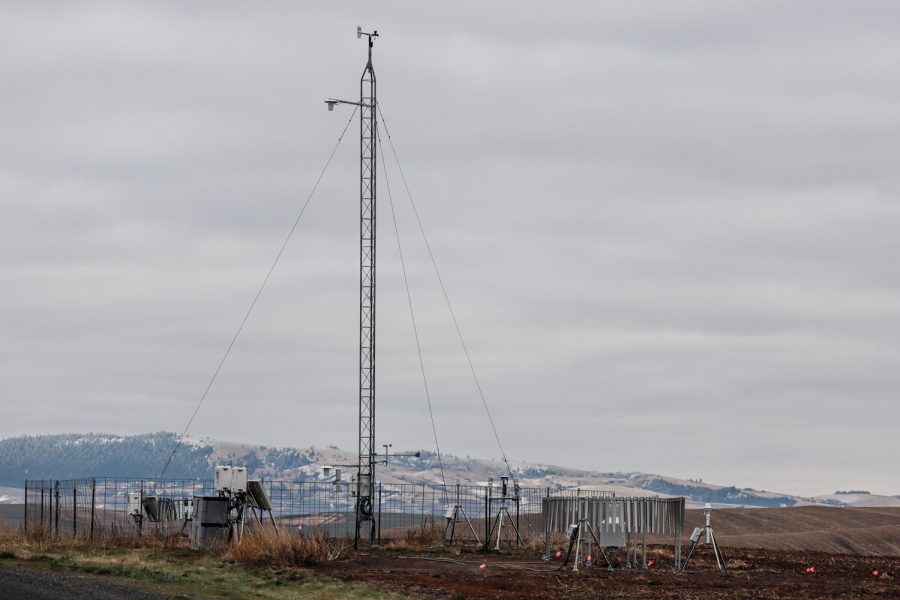WSU’s weather data collection stations receive upgrades statewide
WSU collects weather data for state, submits to national program
Weather tower in Pullman
November 16, 2022
The WSU AgWeatherNet, which collects weather data throughout the state of Washington, is in the process of upgrading its weather stations to enhance its collection techniques.
The AgWeatherNet received $374,488 from the National Mesonet Program, or NMP, this year as compensation for collecting and submitting weather data, said Lav Khot, interim director of the AgWeatherNet.
The NMP relays the data to the National Oceanic and Atmospheric Administration, which uses weather data to inform the public, construct forecasts and study both state and regional climate, Khot said.
Taking weather data is important for the agricultural industry to help them prepare their fields for the conditions. To do this, weather stations take data on wind speed, air temperature, rainfall, solar radiation, relative humidity, soil temperature, and soil moisture, he said.
Currently, the AgWeatherNet has 344 stations spread across the state. Of these, 118 are towers, 101 are tripods and 125 are private. They plan to continue upgrading sites to towers and building new ones, he said.
These towers, called climate-grade weather stations, cost about $17,000-$19,000 to build, he said. If you include the new sensors and rain gauge the total comes out to $25,000 per tower.
“That’s just the hardware cost,” he said. “Once the data comes, we have to have amazon web services storing the data and dispatching the data… that’s gonna be a monthly cost.”
The towers take data every 15 minutes and form a network to take data across the state. Gaps in the network are filled in by the tripods. They plan to build 25 towers per year, but have faced difficulty in staffing and resources, he said.
“Because we have such a huge network, we have to maintain our existing network,” he said.
Upgrading weather stations to towers improves their ability to take accurate measurements and includes installing industry-standard equipment, said Jonathan Contezac, an AgWeatherNet Field Meteorologist.
For starters, most industry models rely on wind speed 10 meters from the ground, which is not possible with the tripod stations, Contezac said. Wind speeds measured ten meters from the ground are typically twenty to thirty percent faster than wind speeds measured two meters from the ground, as they are with tripods.
Additionally, they plan to upgrade the rain gauge sensor mechanisms to utilize a weighing scale, he said.
“The sensors we use now, they’re kind of a tipping mechanism. Internally there’s a see-saw mechanism that goes up and down,” he said.
These see-saw mechanisms are good for measuring rainfall, but the weighing scale will be able to measure all precipitation, including snow and hail, he said.
The towers also come with aerated temperature probes, while the tripods temperature probes are unaerated, he said. The aeration, which is provided by a fan blowing air on the probe, circumvents temperature bias from accumulated solar radiation.
Contezac also hopes to invest in a fuel moisture sensor to predict fire hazards. These would measure relative moisture in brushes and grasses, which are fuel for wildfires.
Contezac said one of the biggest problems for AgWeatherNet in the past 10 years has been funding.
“For the size of our network, we should probably have about 25 full-time employees, and we’re currently operating with five full-time employees,” he said.
Duties of meteorologists include visiting stations three to four times per year to perform regular maintenance, he said. This includes polishing radiation shields, leveling sensors for accurate measurements, running trip tests on rain gauges, mowing grass if needed, and similar routine tasks.
While other state’s networks have an employee assigned to about eight weather stations, Washington’s network has one assigned to every forty, he said.
“We can’t sustain this size network forever,” he said.










